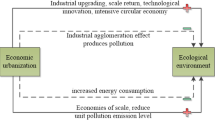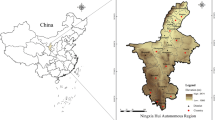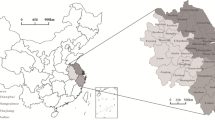Abstract
With the rapid development of industrialization and urbanization and the continuous improvement of social productivity, people are increasingly demanding a higher quality of the living environment. Based on existing research, this study built a compiled index system to evaluate the quality of natural living environment (NLEQ). Thereafter, the spatiotemporal characteristics of NLEQ were analyzed using a panel regression analysis, to explore the mechanism of urbanization through the multi-dimensional method of system–subsystem–factors. The results show that NLEQ significantly improved from 2008 to 2017; resource-environmental quality (REQ) had a north–south difference, while environmental pollution governance (EPG) had an east–west difference due to the different influences of urbanization on NLEQ, REQ, and EPG. Industrial urbanization had a significant influence on REQ, and population urbanization and land urbanization had a significant influence on EPG. These results suggest that more attention should be paid to resource conservation and pollution treatment in the context of rapid urbanization. This article describes the evaluation of NLEQ and discusses the relationship between urbanization and NLEQ from a geographical perspective. It is of critical reference to study regional development imbalances in the natural living environment, in order to construct an ecological civilization.







Similar content being viewed by others
Notes
Tibet was excluded from the scope of the study due to the lack of data.
lnPU, lnIU, lnLU, and LNNLEQ are the logarithms of PU, IU, LU, and NLEQ.
In cancer villages, which emerged after the reform and opening up in China, people have been drinking untreated sewage discharged by upstream enterprises, causing serious damage to human health, and resulting in large-scale diffusion of cancer in the population of entire villages.
References
Ala-Mantila, S., Heinonen, J., Junnila, S., & Saarsalmi, P. (2017). Spatial nature of urban well-being. Regional Studies, 52, 1–15.
Alidoust, D., Suzuki, S., Matsumura, S., & Yoshida, M. (2012). Chemical speciation of heavy metals in the fractionated rhizosphere soils of sunflower cultivated in a humicandosol. Communications in Soil Science & Plant Analysis, 43(17), 2314–2322.
André, M., Joumard, R., Vidon, R., Tassel, P., & Perret, P. (2006). Real-world European driving cycles, for measuring pollutant emissions from high- and low-powered cars. Atmospheric Environment, 40(31), 5944–5953.
Bakand, S., Hayes, A., & Winder, C. (2007). An integrated in vitro approach for toxicity testing of airborne contaminants. Journal of Toxicology and Environmental Health A, 70(19), 1604–1612.
Chang, A. L., Yang, G. D., & Lian, J. Y. (2016). On the concept of ecological civilization in china and Joel Kovel’secosocialism. Capitalism Nature Socialism, 27(1), 1–7.
Chen, X., Naresh, D., Upmanu, L., Hao, Z., Dong, L., Ju, Q., et al. (2014). China’s water sustainability in the 21st century: a climate informed water risk assessment covering multi-sector water demands. Hydrology and Earth System Sciences, 18(5), 1653–1662.
Chubak, J., Boudreau, D. M., Rulyak, S. J., & Mandelson, M. T. (2018). Colorectal cancer risk in relation to antidepressant medication use. Journal of China University of Geosciences, 128(1), 227–232.
Ding, Y., & Peng, J. (2018). Impacts of urbanization of mountainous areas on resources and environment: based on ecological footprint model. Sustainability, 10(3), 765.
Doong, R. A., Lee, S. H., Lee, C. C., Sun, Y. C., & Wu, S. C. (2008). Characterization and composition of heavy metals and persistent organic pollutants in water and estuarine sediments from Gao-ping River Taiwan. Marine Pollution Bulletin, 57(6), 846–857.
Gong, S. S., & Zhang, T. (2013). Temporal-spatial distribution changes of cancer villages in China. China Population, Resources and Environment, 23(9), 156–164. ((in chinese)).
Haarstad, H. (2014). Climate change, environmental governance and the scale problem. Geography Compass, 8(2), 87–97.
Hasenkopf, C. A., Veghte, D. P., Schill, G. P., Lodoysamba, S., Freedman, M. A., & Tolbertcet, M. A. (2016). Ice nucleation, shape, and composition of aerosol particles in one of the most polluted cities in the world: Ulaanbaatar, Mongolia. Atmospheric Environment, 139, 222–229.
Hirschhorn, J. S. (2010). Environment, quality of life, and urban growth in the new economy. Environmental Quality Management, 10(3), 1–8.
Hui, L., Yeerken, W., & Stein, H. (2013). Study of poverty alleviation strategy based on labor force quality improvement and ecological protection in Western China. Chinese Journal of Population, Resources and Environment, 11(3), 218–226. ((In Chinese)).
K Lahiri 2015 Analysis of panel data. Cambridge Books, 87 2 221 222.
Liu, Q., Baumgartner, J., Zhang, Y., & Schauer, J. J. (2016). Source apportionment of Beijing air pollution during a severe winter haze event and associated pro-inflammatory responses in lung epithelial cells. Atmospheric Environment, 126(2), 28–35.
Li, X. M., & Jin, P. Y. (2012). Characteristics and spatial-temporal differences of urban human settlement environment in China. Scientia Geographica Sinica, 32(5), 521–529.
Liu, Y. S., Zhang, Z. W., & Zhou, Y. (2018). Efficiency of construction land allocation in China: An econometric analysis of panel data. Land Use Policy, 74, 261–272.
Liu, Y., Dijst, M., Faber, J., Geertman, S., & Cui, C. (2017). Healthy urban living: Residential environment and health of older adults in Shanghai. Health & Place, 47, 80–89.
Li, Y., Pan, L. G., Li, A., & Wang, B. H. (2015). Suitability evaluation of remediation technology for polluted farmland. International Journal of Agricultural & Biological Engineering, 8(2), 39–45.
Lloyd, K., & Auld, C. (2003). Leisure, public space and quality of life in the urban environment. Urban Policy & Research, 21(4), 339–356.
Jin, F. J. (2001). Infrastructure and the living environment of human being. Progress in Geography, 20(3), 114–120. ((in chinese)).
Jr, E. A. G., & Grove, D. C. (2010). United Nations conference on the human environment, Stockholm, 1972. Museum International, 25(1–2), 117–119.
Kelemen, R. D., & Vogel, D. (2010). Trading places: The role of the United States and the European union in international environmental politics. Comparative Political Studies, 43(4), 427–456.
Kennedy, J. (2000). Electrochemical approaches to environmental problems in the process industry. Electrochimica Acta, 45(15–16), 2575–2594.
Kim, J. H., Lee, C., & Sohn, W. (2016). Urban natural environments, obesity, and health-related quality of life among hispanic children living in inner-city neighborhoods. International Journal of Environmental Research & Public Health, 13(1), 121.
Kim, S. G., Cho, S. H., Lambert, D. M., & Roberts, R. K. (2010). Measuring the value of air quality: Application of the spatial hedonic model. Air Quality Atmosphere & Health, 3(1), 41–51.
Korn, A. (1972). Human environment conference. Science, 175(4017), 10.
Knoedler, J. (2011). Creating modern capitalism: How entrepreneurs, companies, and countries triumphed in three industrial revolutions. Journal of Economic Issues, 32(4), 140–142.
Maas, J., Verheij, R. A., Vries, S. D., Spreeuwenberg, P., Schellevis, F. G., & Groenewegen, P. (2009). Morbidity is related to a green living environment. Journal of Epidemiology and Community Health, 63(12), 967–973.
Mccarthy, J. (2010). Scale, sovereignty, and strategy in environmental governance. Antipode, 37(4), 731–753.
Nzila, A., Thukair, A., Sankara, S., & Razzak, S. A. (2017). Characterization of aerobic oil and grease-degrading bacteria in wastewater. Environmental Technology Letters, 38(6), 661–670.
Peak, R. G., & Iii, F. R. T. (2013). Amount and type of forest cover and edge are important predictors of golden-cheeked warbler density. Condor, 115(3), 659–668.
Panagopoulos, T., Duque, J. A. G., & Dan, M. B. (2016). Urban planning with respect to environmental quality and human well-being. Environmental Pollution, 208, 137–144.
Qi, X. X., Fu, Y. H., Wang, R. Y., Ng, C. N., Dang, H. P., & He, Y. L. (2018). Improving the sustainability of agricultural land use: An integrated framework for the conflict between food security and environmental deterioration. Applied Geography, 90, 214–223.
Qu, Y. B., Jiang, G. H., Shang, R., & Gao, Y. (2016). Type classification of rural settlements and its consolidation models based on the coupling of system factor characteristics. Actascientiarumnaturaliumuniversitatis pekinensis, 52(06), 1057–1067.
Robles-Sikisaka, R., Ly, M., Boehm, T., Naidu, M., Salzman, J., & Pride, D. T. (2013). Association between living environment and human oral viral ecology. Isme Journal, 7(9), 1710–1724.
Rodrigues, D., Padez, C., & Machado-Rodrigues, A. M. (2017). Perceived psychological, cultural, and environmental barrier to sport in children living in urban and non-urban settings in the Midlands, Portugal. Sport Sciences for Health, 1, 1–7.
Sánchezgonzález, E. (2009). Trends in soil environmental pollution and the prevention-controlling-remediation strategies in China. Environmental Pollution & Control, 69(4), 6–11.
Slavuj, L. (2012). Life quality in urban neighbourhood–advantages and drawbacks of immediate living environment. Sociologija I Prostor, 50, 183–201.
Soffianian, A., Madani, E. S., & Arabi, M. (2014). Risk assessment of heavy metal soil pollution through principal components analysis and false color composition in Hamadan Province Iran. Environmental Systems Research, 3(1), 1–14.
Song, W. (2014). Decoupling cultivated land loss by construction occupation from economic growth in Beijing. Habitat International, 43(43), 198–205.
Vega-Retter, C., Muñoz-Rojas, P., Vila, I., Copaja, S., & Véliz, D. (2014). Genetic effects of living in a highly polluted environment: the case of the silverside Basilichthys microlepidotus (Jenyns) (Teleostei: Atherinopsidae) in the Maipo River basin, central Chile. Population Ecology, 56(4), 569–579.
Wang, N. L., Zhu, H. M., Guo, Y. W., & Peng, C. (2018). The heterogeneous effect of democracy, political globalization, and urbanization on PM2.5 concentrations in G20 countries: Evidence from panel quantile regression. Journal of Cleaner Production, 194(1), 54–68.
Williams, P. (2017). Standards for safety, security, and interoperability of medical devices in an integrated health information environment. Journal of Ahima, 88(4), 32.
Wojciechowska, E., Nawrot, N., Walkusz-Miotk, J., Matej-Łukowicz, J., Pazdro, K., & Ksenia. . (2019). Heavy metals in sediments of urban streams: Contamination and health risk assessment of influencing factors. Sustainability, 11(3), 563.
Wong, C. S. M., Chan, W. C., Lam, L. C., Law, W. Y., Tang, H. W. Y., Wong, T. Y., & W., & Chen, E. . (2016). Living environment and psychological distress in the general population of Hong Kong. Procedia Environmental Sciences, 36, 78–81.
Wu, T. Y., Guo, N., The, C. Y., & Hay, J. X. W. (2013). Advances in ultrasound technology for environmental remediation. Springerbriefs in Molecular Science, 26(1), 1–27.
Xie, T., Wang, M., Chen, W. P., & Uwizeyimana, H. (2019). Impacts of urbanization and landscape patterns on the accumulation of heavy metals in soils in residential areas in Beijing. Journal of Soils and Sediments, 19(1), 148–158.
Yu, J., Cheung, K. W., Yan, W. H., Li, Y. X., & Ho, D. (2017). High-sensitivity low-power tungsten doped niobium oxide nanorods sensor for nitrogen dioxide air pollution monitoring. Sensors & Actuators B Chemical, 238, 204–213.
Zafar, S., & Zaidi, A. (2019). Impact of urbanization on basin hydrology: A case study of the Malir Basin, Karachi Pakistan. Regional Environmental Change, 19(6), 1815–1827.
Zvonovskii, V., & Belousova, R. (2007). Young people in the secondary employment market. Russian Education & Society, 49(5), 26–48.
Acknowledgements
This research was funded by the “Youth Program of National Natural Science Foundation of China” (42001192), the “China Postdoctoral Science Foundation” (2019M662329) , and supported by “The Fundamental Research Funds of Shandong University” (2018GN061).
Author information
Authors and Affiliations
Corresponding author
Additional information
Publisher's Note
Springer Nature remains neutral with regard to jurisdictional claims in published maps and institutional affiliations.
Rights and permissions
About this article
Cite this article
Li, J., Jiang, C. & Xing, Z. Multi-dimensional influence measurement of urbanization on the quality of natural living environment in China. Environ Dev Sustain 23, 12151–12168 (2021). https://doi.org/10.1007/s10668-020-01162-6
Received:
Accepted:
Published:
Issue Date:
DOI: https://doi.org/10.1007/s10668-020-01162-6




